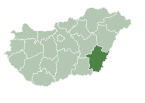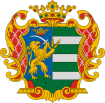Békés
This article needs additional citations for verification. (May 2021) |
Békés | |
|---|---|
 Békés from above | |
|
UTC+2 (CEST) | |
| Postal code | 5630 |
| Area code | (+36) 66 |
| Website | www |
Békés (Hungarian pronunciation: [ˈbeːkeːʃ]; Romanian: Bichiș; Slovak: Békéš) is a town in Békés County, Hungary. It lies about 10 km (6 mi) north of Békéscsaba and 190 km (118 mi) east of Budapest.
History
The area of the present town has been inhabited since ancient times, due to its good soil and proximity to rivers. After the
In 1566, the castle of Gyula was occupied by the
During the freedom fight led by Prince Francis II Rákóczi in the early 18th century the area of Békés was deserted again, for the last time. In 1720 John George Harruckern was granted Békés county via Royal Deed. He gave privileges to the serfs of the area, and gradually the population grew.
By the end of the 18th century, the town already had its present five districts and the
In 1872, Békés was re-classified as a village. It was not until a hundred years later that it got its town status back.

Around the start of the 20th century, Békés was rapidly developing and several new buildings were built. During the World Wars, there were no significant battles in the area. Békés was freed from the Nazis on October 6, 1944. After the war, industrialization quickened. On April 15, 1973, Békés was granted town status.
Today, Békés is made of several ethnic groups, including Hungarians, Roma, and with its near proximity to the Romanian border, Romanians who constitute approximately 5% of the population.[citation needed]
Sights

- Széchenyi Square (main square) with several historical buildings
- Town hall
- Protestant church (Zopf style)
- Roman Catholic church (1795)
- Greek Orthodox church (one of the northernmost ones)
- Jewish synagogue (partially restored, interior and woman's gallery preserve its original form, now a pálinka center)
- School museum
- Several bridges on the backwaters of the regulated Körös river; Békés is called the "town of bridges" because of them
- Small-boat harbour
Twin towns – sister cities
 Gheorgheni, Romania
Gheorgheni, Romania Myszków, Poland
Myszków, Poland Novi Itebej (Žitiště), Serbia
Novi Itebej (Žitiště), Serbia
References
- ^ "Testvérvárosok". bekesvaros.hu (in Hungarian). Békés. Retrieved 2021-04-06.
External links
- Official website in Hungarian, English and German
- . Encyclopædia Britannica. Vol. III (9th ed.). 1878. p. 511.
- Official news website of Békés


